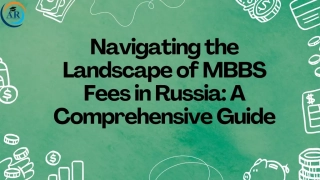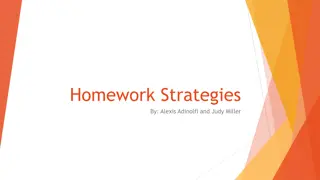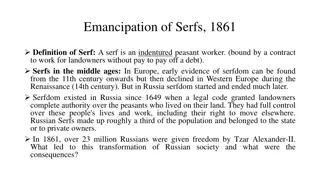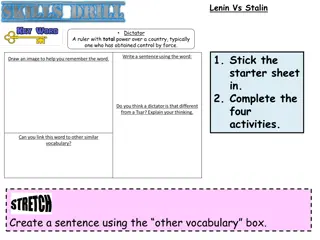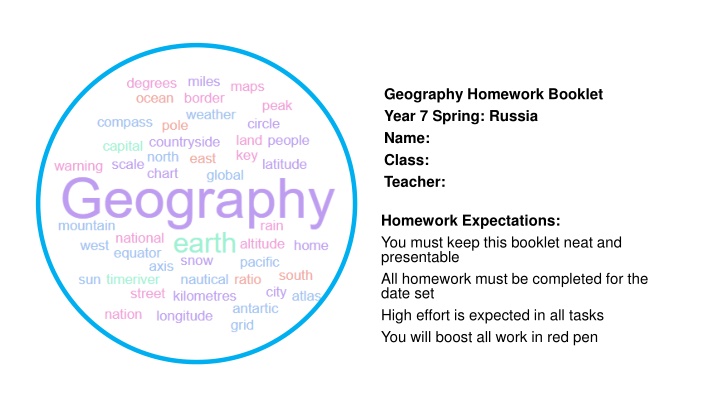
Discovering Russia: Geography Homework Challenges for Year 7 Students
Immerse yourself in the fascinating world of Russia with these engaging Year 7 geography homework tasks. Explore the physical features, national parks, biomes, and climate of Russia while enhancing your knowledge and geographical skills. From identifying key locations to understanding unique geological formations, this booklet offers a comprehensive learning experience for young enthusiasts. Stay organized, boost your efforts, and delve into the wonders of Russia with each task.
Download Presentation

Please find below an Image/Link to download the presentation.
The content on the website is provided AS IS for your information and personal use only. It may not be sold, licensed, or shared on other websites without obtaining consent from the author. If you encounter any issues during the download, it is possible that the publisher has removed the file from their server.
You are allowed to download the files provided on this website for personal or commercial use, subject to the condition that they are used lawfully. All files are the property of their respective owners.
The content on the website is provided AS IS for your information and personal use only. It may not be sold, licensed, or shared on other websites without obtaining consent from the author.
E N D
Presentation Transcript
Geography Homework Booklet Year 7 Spring: Russia Name: Class: Teacher: Homework Expectations: You must keep this booklet neat and presentable All homework must be completed for the date set High effort is expected in all tasks You will boost all work in red pen
Year 7 Weekly Homework Spring 1.1 Physical Features of Russia Knowledge Book: P49-50 1. Are these statements TRUE or FALSE? 3. Describe the location of Russia using the map below [4 marks]: 1. Russia is the largest country on Earth: _______________________ N 2. It covers 1/5 of all land on Earth: _______________________ 3. It has a population of 1.4 billion: _______________________ 4. 20% of the worlds forests are found there: _______________________ 5. The capital city is Moscow: _______________________ 6. Russia is mostly located in Europe: _______________________ 7. It s surrounded by the Arctic and Pacific Ocean: _______________________ 2. Answer the following questions using P49-50 in your KB: 1. What mountain range is found in Russia? __________________________________________________ __________________________________________________ __________________________________________________ __________________________________________________ __________________________________________________ __________________________________________________ __________________________________________________ __________________________________________________ __________________________________________________ 2. How tall is Mount Elbrus? 3. Across how many time zones does Russian span? 4. Which two continents is Russia located in? 5. Why can t Russia use its coastal ports all year round?
Year 7 Weekly Homework Spring 1.2 Recap: The UK s National Parks Knowledge Book: P21-23 1. Answer the following questions: 3. Explain two reasons why the tourism numbers in national parks have increased: a) What is a national park? b) In what year was the UK s first national park established? c) What is the name of the UK s first national park? d) Who manages the national parks? e) How many national parks are there in England and Wales? 2. Identify the UK s national parks: 4. Tick the correct box for which the following statements are true: Statement Limestone Gritstone This rock is also referred to as the White Peak 1- Cairngorms 10- 1 2- Loch Lomond and the Trossachs 11- This rock is soluble so it can be dissolved 2 3- 12- This rock is also referred to as the Dark Peak 3 4- 13- Intricate cave systems have been carved out of this rock type 4 5 6 5- 14- This rock is insoluble 7 6- 15- 9 8 This rock supports the heather moorland and bog environments 7- 11 10 8- These areas are intensively farmed with sheep and dairy usage 12 15 13 14 9-
Year 7 Weekly Homework Spring 1.3 The Biomes and Climate of Russia Knowledge Book: P51, P56 1. Label North-East Russia and Central Russia onto the climate diagram: 2. P56: Make links between the words explain at least 4 links you make Tundra Seasons Plants/ Vegetation Russia Taiga 3. Answer the following questions: 4. Tick the correct box for which the following statements are true: Statement Tundra Taiga a) What are the two main biomes that exist in Russia? Plants including: fungus, grasses and shrubs grow here b) TRUE or FALSE: Russia experiences high volumes of rainfall throughout the year? Found in the northern hemisphere Coniferous forests grow in this biome c) In January, what are the temperatures in West Russia like, compared to the temperatures in East Russia? Located mostly in northern Russia Largest biome in Russia d) What percentage of the worlds conifers are found in Russia? This biome experiences very cold temperatures
Year 7 Weekly Homework Spring 1.4 Russia s Population Knowledge Book: P57 1. Fill in the key terms and definitions for the following: 3. Look at the reasons for population density on P57, sort them into reasons for a sparse population and reasons for a dense population. Can you add any of your own? Key Term Definition Reasons for a dense population Reasons for a sparse population Rich soil for farming A small amount of people in a given area. Densely Populated Choropleth Map The number of people living in a given area, usually within 1km 4. Create your own choropleth map by shading in the population density of Russia. Use a pencil and REMEMBER your key!! (The black shading already on the map is Moscow) Densely Populated Medium Populated Sparsely Populated 2. Draw an image/ icon for the following key terms: Choropleth Map Densely Populated
Year 7 Weekly Homework Spring 1.5 Russia s Economy Knowledge Book: P58 1. Fill in the definitions for the following key terms: 3. Around the mind-map, label all of the natural resources available in Russia: Key Term Definition Coal Primary Sector Natural Resources in Russia Secondary Sector Tertiary Sector 2. Using a protractor and a pencil, complete the pie chart to show Russia s economy by marking on the degrees: 4. Answer the following questions: a) What percentage of the worlds natural gas comes from Russia? b) What mode of transport does Russia mostly use to transport goods? Primary: 9.4% (34 ) c) What is the name of Russia s capital city? Secondary: 27.6% (99 ) d) Why are Russian roads in poor condition? Tertiary: 63% (227 ) e) Why do you think Russia struggles to move goods from the East to the West?
Year 7 Weekly Homework Spring 1.6 Recap: UK Trade Knowledge Book: P24-25 1. Decide whether the following statements are TRUE or FALSE: 3a. Use P25 to define the following key terms: Imports- a) Manufacturing in the UK has declined ________________ Exports- b) Iron, steel, ship building and textiles are still big business in the UK ________________ c) Toyota has 1 plant/site in the UK ________________ 3b. Use imports and exports in a sentence: d) In 1992 the first car drove off the production line at Burnaston _______________ ____________________________________________________________________________ e) Derbyshire is a central county in the UK _______________ ____________________________________________________________________________ f) The government is dissuading (putting off) foreign industries _______________ ____________________________________________________________________________ g) Burnaston is a 60 acre site ________________ ____________________________________________________________________________ h) A lack of trade and industry has led to unemployment ________________ ____________________________________________________________________________ 4. Connect these words (you must make at least 4 connections): 2. Explain two reasons why Toyota chose Burnaston: Exports One reason Toyota chose Burnaston was __________________________________________ Imports ____________________________________________________________________________ This means that _____________________________________________________________ United Kingdom ____________________________________________________________________________ ____________________________________________________________________________ Another reason Toyota chose Burnaston was _______________________________________ ____________________________________________________________________________ Economy This means that _____________________________________________________________ ____________________________________________________________________________ Manufactured Goods ____________________________________________________________________________ Trade
Year 7 Weekly Homework Spring 1.7 Map Skills: Grid References Knowledge Book P11 1. Complete the questions on 4 and 6 figure grid references: 4 Figure Grid References: a) What is the 4 figure grid reference for the ? _______________________________ b) What is the 4 figure grid reference for the ? _______________________________ c) What is the 4 figure grid reference for the ? _______________________________ d) What is the 4 figure grid reference for the ? _______________________________ e) Which shape is found in grid reference 23,46? _________________________________ f) Which shape is found in grid reference 21,48? _________________________________ g) Which shape is found in grid reference 23,47? _________________________________ h) Draw a in grid reference 21,47 6 Figure Grid References: a) What is the 6 figure grid reference for the ? _______________________________ b) What is the 6 figure grid reference for the ? _______________________________ c) What is the 6 figure grid reference for the ? _______________________________ d) What is the 6 figure grid reference for the ? _______________________________ e) Which shape is found in grid reference 225,468? ______________________________ f) Which shape is found in grid reference 248,488? ______________________________ g) Which shape is found in grid reference 212,452? ______________________________ h) Draw a in grid reference 236,453
Year 7 Weekly Homework Spring 1.8 Glaciation in Russia Knowledge Book: P52-55 1. Fill in the definitions for these key terms: 3. Use P55 to assist you labelling the four types of glacial moraine onto the diagram: Key Term Definition Glacier Abrasion Till Morraines Erratics 2. Read the last section on P52. Describe what freeze-thaw weathering is, then draw an icon to help you remember: 4. Decide whether the following statements are TRUE or FALSE: ___________________________________________ a) Glacier erode the land through hydraulic action and abrasion _______________ ___________________________________________ b) Glaciers are fast flowing rivers of ice _______________ ___________________________________________ c) A U-Shaped Valley is a landform of erosion __________________ ___________________________________________ d) Drumlins are shallow at the upstream end and steep at the downstream end __________ ___________________________________________ ___________________________________________ e) Glaciers can transport material over long distances ______________ ___________________________________________ f) The heavy weight of glaciers causes them to move downhill ______________ ___________________________________________ g) All the glaciers that ever existed are now completely melted _______________ ___________________________________________
Year 7 Weekly Homework Spring 1.9 Russia and the Arctic Knowledge Book: P60-61 Read the article (to the left) and answer the following questions: New Survey of Arctic s mineral riches could stoke international strife a) Which two minerals have been discovered in the Arctic? _____________________________ The battle for the Arctic s hidden mineral riches is likely to get worse after a survey revealing the energy reserves present beneath the ice. b) What global percentage of these minerals lie in the Arctic? __________________________ _______________________________________________________________________________ c) Why is it now easier to access these two minerals in the Arctic? _______________________ A map of potential oil and gas reserves in the region, published today in Science Magazine, shows that about 30% of the world s unexploited gas and 13% of oil, lie under the seas around the North Pole. Billions of barrels of oil and trillions of cubic feet of gas lie within the Arctic Circle, where, until now, permanent ice has prevented drilling. One-third of that oil and more than half of the gas is buried on an off Russia s coastline. _______________________________________________________________________________ _______________________________________________________________________________ d) Having read the article, why do you think Russia is keen to control the Arctic? Explain your reasons. ____________________________________________________________________ _______________________________________________________________________________ The report is likely to further stoke international competition for mineral, tourism and shipping rights in the region. Exploration and drilling for oil and gas have become easier as warming temperatures melt the ice, and all countries with borders inside the Arctic Circle are fighting to claim their share. For better or worse, limited exploration prospects in the rest of the world combined with technological advances make the Arctic increasingly attractive for development, said Paul Berkman of the Scott Polar Research Institute at the University of Cambridge. _______________________________________________________________________________ _______________________________________________________________________________ e) How could we put a stop to any conflict that may occur due to countries arguing over who should control the Arctic? ______________________________________________________ _______________________________________________________________________________ _______________________________________________________________________________ _______________________________________________________________________________
Year 7 Weekly Homework Spring 2.0 Recap: How does a Meander Form? Knowledge Book: P19 1. Use P19 to label the diagram below: 3. Use P12 to define the following key terms: Erosion- ____________________________________________________________________ Deposition- _________________________________________________________________ 4. Use erosion and deposition in a sentence: ____________________________________________________________________________ ____________________________________________________________________________ ____________________________________________________________________________ ____________________________________________________________________________ 5. Match the term to the definition 2a. Describe the formation of river cliffs. ____________________________________________________________________________ Key Term Definition ____________________________________________________________________________ Rocks carried by the river rub and scrape along the riverbed and banks, wearing them down. Hydraulic Action ____________________________________________________________________________ Slightly acidic water dissolves certain types of rock. Abrasion 2b. Describe the formation of slip off slopes. The force of the river water compresses air into cracks along the river banks. Attrition ____________________________________________________________________________ ____________________________________________________________________________ Rocks carried by the river collide with each other and break into smaller pieces. Solution ____________________________________________________________________________
Questions to ask: ___________________________ ___________________________ ___________________________ ___________________________ ___________________________ ___________________________ ___________________________ ___________________________ ___________________________ ___________________________ ___________________________ ___________________________ ___________________________ ___________________________ ___________________________ ___________________________ ___________________________ Notes: ___________________________ ___________________________ ___________________________ ___________________________ ___________________________ ___________________________ ___________________________ ___________________________ ___________________________ ___________________________ ___________________________ ___________________________ ___________________________ ___________________________ ___________________________ ___________________________ ___________________________
Questions to ask: ___________________________ ___________________________ ___________________________ ___________________________ ___________________________ ___________________________ ___________________________ ___________________________ ___________________________ ___________________________ ___________________________ ___________________________ ___________________________ ___________________________ ___________________________ ___________________________ ___________________________ Notes: ___________________________ ___________________________ ___________________________ ___________________________ ___________________________ ___________________________ ___________________________ ___________________________ ___________________________ ___________________________ ___________________________ ___________________________ ___________________________ ___________________________ ___________________________ ___________________________ ___________________________
Questions to ask: ___________________________ ___________________________ ___________________________ ___________________________ ___________________________ ___________________________ ___________________________ ___________________________ ___________________________ ___________________________ ___________________________ ___________________________ ___________________________ ___________________________ ___________________________ ___________________________ ___________________________ Notes: ___________________________ ___________________________ ___________________________ ___________________________ ___________________________ ___________________________ ___________________________ ___________________________ ___________________________ ___________________________ ___________________________ ___________________________ ___________________________ ___________________________ ___________________________ ___________________________ ___________________________
Questions to ask: ___________________________ ___________________________ ___________________________ ___________________________ ___________________________ ___________________________ ___________________________ ___________________________ ___________________________ ___________________________ ___________________________ ___________________________ ___________________________ ___________________________ ___________________________ ___________________________ ___________________________ Notes: ___________________________ ___________________________ ___________________________ ___________________________ ___________________________ ___________________________ ___________________________ ___________________________ ___________________________ ___________________________ ___________________________ ___________________________ ___________________________ ___________________________ ___________________________ ___________________________ ___________________________

